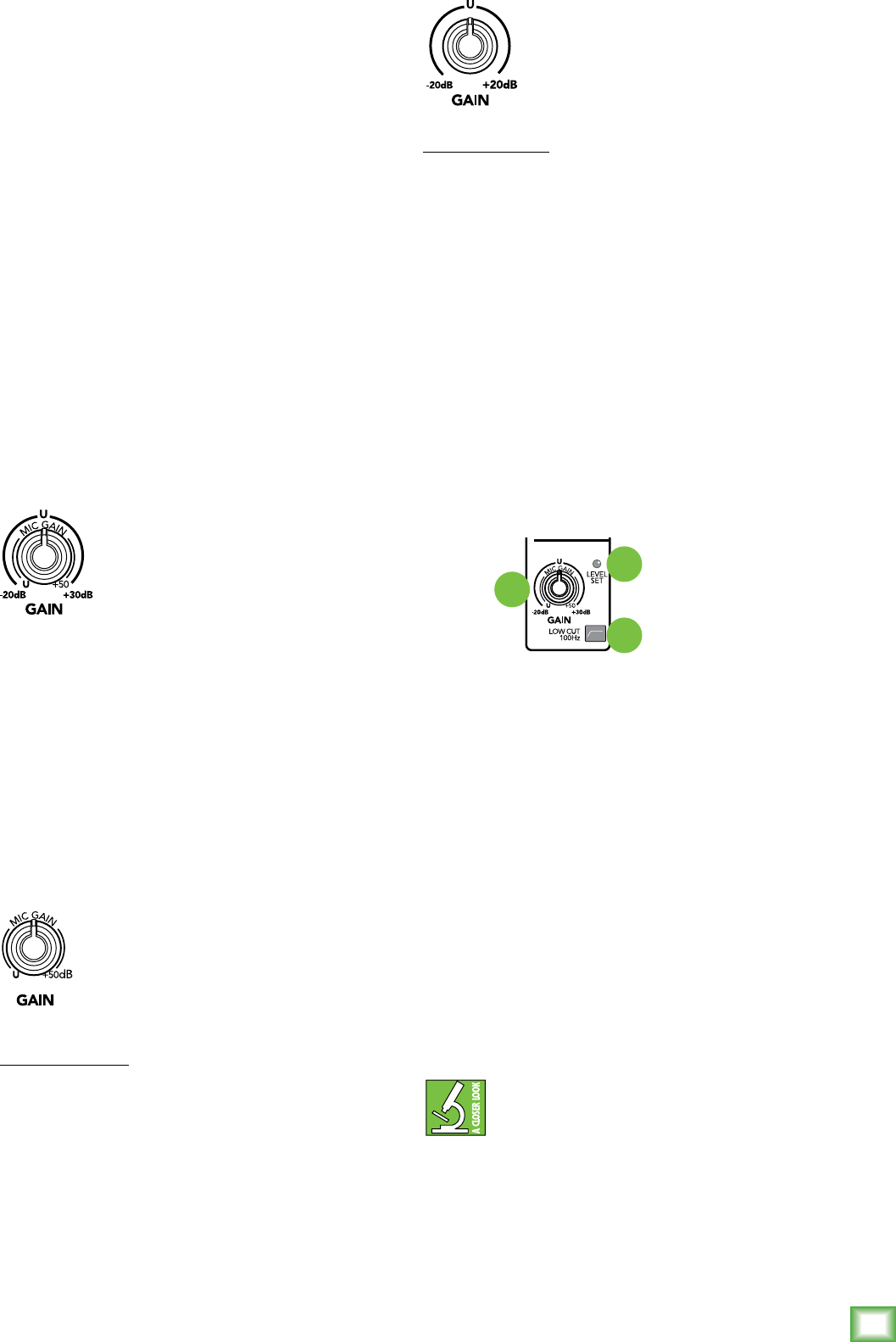
Owner’s Manual
11
Owner’s Manual
“U” like Unity gain
ProFXv2 Series mixers have a “U” symbol on almost
every level control. It stands for “unity gain,” meaning
no change in signal level. The labels on the controls
are measured in decibels (dB), so you’ll know what
you’re doing level-wise if you choose to change a
control’s settings.
10. Gain
If you haven’t already, please read the "Getting
Started" section on page 4. Setting the gain correctly
will ensure that the preamplifier’s gain is not too high,
where distortion could occur, and not too low, where
the quieter, exquisitely-delicate passages might be lost
in background noise.
The gain knobs adjust the input sensitivity of the mic
and line inputs. This allows signals from the outside
world to be adjusted to run through each channel at
optimal internal operating levels.
For mono channels (mic input with
a mono line input), the gain knob
adjusts the input sensitivity of the
mic and line inputs.
If the signal originates through the mic XLR jack,
there will be 0 dB of gain with the knob fully down,
ramping to 50 dB of gain fully up.
Through the 1⁄4" mono line inputs, there is 20 dB of
attenuation fully down and 30 dB of gain fully up, with
unity gain “U” at 12:00.
This 20 dB of attenuation can be very handy when you
are inserting a hot signal, or when you want to add EQ
gain, or both. Without this “virtual pad,” there is more
chance of channel clipping.
For hybrid channels (mic input and stereo
line input), the gain control just affects the
microphone input.
Hybrid Channels:
• ProFX8v2 – Channels 3/4 and 5/6
• ProFX12v2 – Channels 5/6 and 7/8
• ProFX16v2 – Channels 9/10 and 11/12
• ProFX22v2 – Channels 15/16 and 17/18
• ProFX30v2 – Channels 23/24 and 25/26
For stereo channels (no mic input)
the gain control affects the line-level
inputs, with 20 dB of gain, and 20 dB
of attenuation.
Stereo Channels:
• ProFX8v2 – Channels 7/8
• ProFX12v2 – Channels 9/10 and 11/12
• ProFX16v2 – Channels 13/14 and 15/16
• ProFX22v2 – Channels 19/20 and 21/22
• ProFX30v2 – Channels 27/28 and 29/30
11. Level Set LED [ProFX8v2 / ProFX12v2]
These LEDs are used with the gain control to set the
channel preamplifier gain just right for each source.
If one or more channels are distorting, check the level
set LEDs. If they are on continuously, turn down the
gain.
12. Low Cut Switch
All mono channels have a low-cut switch (often
referred to as a high-pass filter) that cuts bass
frequencies below 100 Hz at a rate of 18 dB per octave.
We recommend that you use low-cut on every
microphone application except kick drum, bass guitar,
or bassy synth patches. These aside, there isn’t much
down there that you want to hear, and filtering it
out makes the low stuff you do want much more crisp
and tasty. Not only that, but low-cut can help reduce
the possibility of feedback in live situations, and it
helps to conserve amplifier power.
Another way to consider low-cut’s function
is that it actually adds flexibility during live
performances. With the addition of low-cut,
you can safely use low equalization on vocals.
Many times, bass shelving EQ can really benefit voices.
Trouble is, adding low EQ also boosts stage rumble,
mic handling clunks and breath pops from way-down
low. Applying low-cut removes all those problems,
so you can add low EQ without blowing the woofers.
ProFX8v2
ProFX12v2
11
12
10


















